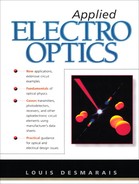Book Description
A "back-to-basics" guide to opto-electronic circuit design and construction.
To successfully build and optimize opto-electronic circuits, you need to understand both the fundamentals of optics and electronics. Applied Electro-Optics provides engineers, designers and technicians with a firm background in both optical physics and circuit design.
In Part I, the book introduces the basic theory of opto-electronics, including:
Maxwell's equations and the wave nature of light
Reflection and refraction, with extensive coverage of Snell's Law Interference phenomena and the Fabry-Perot interferometer
Diffraction effects and diffraction gratings
Polarization and electro-optic modulation
Photons, basic quantum theory, and spectroscopic techniques
Then, in Part II, the book introduces each major element of an electro-optic system. Understand semiconductor light sources such as LEDs and diode lasers. Consider optical transmitters and discover how to minimize the impact of electromagnetic interference through careful circuit location, grounding, and shielding.
Review the basic structure and operation of photodiodes, phototransistors, optocouplers, and photoconductors. Then, learn practical techniques for managing the trade-offs required to integrate these devices into useful circuits. A full chapter on optical receivers demonstrates how to integrate photodetectors into useful receiver circuits; both amplifier and hybrid circuits are covered. Finally, walk step-by-step through building and optimizing circuits for a variety of applications, including CD players and infrared data transmission.
If your goal is to build the best possible opto-electronic circuits or just to understand how they operate, Applied Electro-Optics delivers just the right balance of theory and practice to help you.
